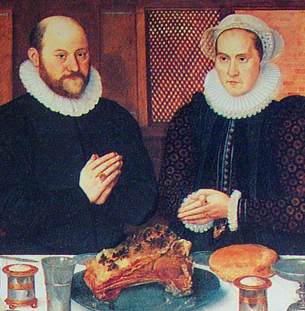The rising middle class
During the Tudor and early Stuart period there was a great increase in social mobility, with wealth and political influence shifting from the nobility and clergy towards a "middling class" of gentry, yeomen and burghers. These were the people represented in the House of Commons, and who eventually challenged royal sovereignty.
How did a middle class develop from the feudal stratification of rulers and serfs?
- Inflation and population*
- Centralization of government*
- The Reformation and the middle class*
- The rise of Capitalism*
Footnotes
-
Inflation and population
Social change was closely linked with inflation and the growth of population throughout the 16th century, particularly in their effect upon capital and labour.
Landowners not restricted by long-term lease agreements boosted their rents to meet inflation, while a labour surplus enabled them to pay lower wages. Profits from rising agricultural prices provided capital for "enclosing" open fields and pasture to raise sheep, or to cultivate their lands more efficiently on a large scale (thus becoming capitalist farmers).
-
Centralization of government
The centralization of government under the Tudors, and a growing bureaucracy, both reduced the power of "over-mighty" nobles, while concentrating local authority in the hands of a middle class officialdom.
As Justices of the Peace, the gentry held the most important administrative posts in the counties and were ultimately responsible for maintaining law and order. Wealthy yeomen typically held positions of local influence as Constables, but could enter the lower gentry with relative ease by purchasing a coat of arms (Shakespeare's father was gentrified in this way). Sons of gentry and yeomen who studied at the universities and Inns of Law could potentially rise even into the nobility, as education was a key to obtaining high office. Or they might become the apprentices of merchants and rise to become leading figures in towns or cities.
-
The Reformation and the middle class
The Reformation increased the power of the laity over the Church at every level of society, and Henry VIII's dissolution of the monasteries brought vast estates into the possession of the rural gentry.
In a less materialistic sense, the Reformation helped enrich the middle classes through the Protestant emphasis upon the individual in terms of faith, self-knowledge, and morality. By praising hard work, self-discipline, and simple living the Puritans advocated a work ethic that promised economic success.
-
The rise of Capitalism
A commercial revolution began with the rise of capitalist entrepreneurs and the expansion of trade to new markets.
Capitalist entrepreneurs were usually merchants whose experience with trade taught them how to profit from being a "middleman." They moved industry into the countryside to escape the guild restrictions of towns, manufacturing cloth on a larger scale by using the "putting-out" system: the entrepreneur would buy wool or flax from farmers, then distribute it to rural workers to card, spin, and weave in their homes. This cottage industry provided valuable occasional income for the families of farmers and labourers, many of whom were hovering on the edge of poverty and starvation.
